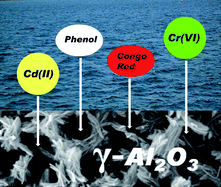Hierarchical spindle-like γ-Al2O3 materials were prepared in the form of fray ended bundles of twisted nanoflakes by a non-template hydrothermal synthesis and sequential calcination route using aluminium nitrate or aluminium chloride as precursors and urea as precipitating agent. The microstructures, morphologies and textural properties of the resulting materials were characterized by X-ray diffraction (XRD), field-emission scanning electron microscopy (FE-SEM), transmission electron microscopy (TEM) and N2 adsorption–desorption techniques. It was found that the spindle-like γ-Al2O3 particles are composed of at least three levels of hierarchical organization: polycrystalline γ-Al2O3 at the nanoscale, oriented nanoflakes and uniform spindle-like assemblies. The hierarchical γ-Al2O3 particles prepared from aluminium nitrate show a slightly smaller size, fewer self-organized nanoplatelets and better textural properties than γ-Al2O3 prepared from aluminium chloride, due to the larger aqueous ionic radius of NO3− than that of Cl−. The reported experiments allowed us to propose the mechanism of formation of the spindle-like assemblies, which involves self-transformation of metastable amorphous aluminium hydroxide particles and their sequential cooperative assembly. The as-prepared γ-Al2O3 was found to be effective adsorbent for the removal of selective pollutants from wastewater as a result of its unique hierarchical structure and high specific surface area, indicating a promising potential of this material for environmental remediation.

You have access to this article
 Please wait while we load your content...
Something went wrong. Try again?
Please wait while we load your content...
Something went wrong. Try again?


 Please wait while we load your content...
Please wait while we load your content...